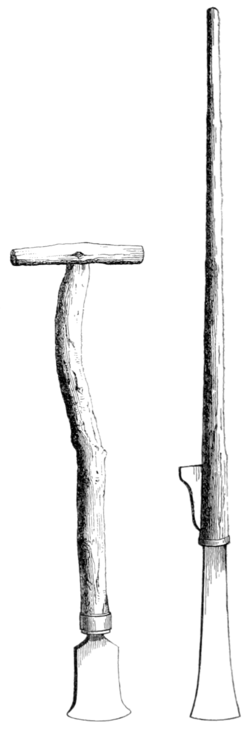Mr. Yates read an interesting communication, which he had received since the publication of his Memoir on the use of Bronze celts, from Dr. C. J. Thomsen, of Copenhagen. He had kindly sent two drawings, copied in the annexed wood-cuts, which show the form of the "paalstav," now used in Iceland, and called there by that name.[1] They are drawn one-eighth of the real size: the blade is, consequently, about 8 centimetres (rather more than three inches) broad. The larger of the two implements is 1⋅09 metre long, including its haft. The only circumstance in which it differs from the ancient celt of Mr. Du Noyer's fourth class, is that, instead of being attached to the haft by thongs or cords, as Mr. Yates had supposed to have been the case anciently, in these implements the bottom of the shaft is bound by an iron ring; and there seems to be no reason to doubt that a metallic ring may have been used occasionally in ancient, just as in modern times. Dr. Thomsen remarks, that these palstaves are used to break the ice in winter, and to part the clods of earth, which, in Iceland, is dug and not ploughed. This presents a striking coincidence with the precepts of Roman writers on agriculture: "Nee minus dolabra quam vomere bubulcus utatur;" and "Glebæ dolabris dissipandæ." The reader will observe in the larger of these two figures a confirmation of Mr. Yates' conjecture respecting the use of the vangila. In addition to the numerous localities mentioned in his Memoir, Dr. Thomsen has heard that palstaves have been found in ancient stone quarries in Greece.
Mr. Yates exhibited also drawings of some remarkable bronze celts, preserved at Paris, in the Museums of Antiquities at the Louvre and at the Bibliotheque Nationale. They are novel types, unknown among English antiquities of this nature. Another bronze object, which he had noticed on the continent, appeared to have been intended to form the core of a mould.
Mr. Birch communicated a memoir illustrative of an interesting fragment of basalt, portion of an ancient Egyptian calendar, in the form of a circular vase, and sculptured with hieroglyphics, amongst which occur twice the cartouches containing the name and titles of Philip Arrhidæus. This fragment comprises the month Tybi, corresponding to November, with part of
- ↑ Meaning, perhaps, the labouring staff, from the Icelandic verb pula, or pala, to labour. Mr. Yates has with much kindness added these curious illustrations, above given, to the valuable series of woodcuts, previously presented by him to the Institute.

